When it comes to botanical longevity, it’s fair to say that annual and biennial species of plants are the “here today, gone tomorrow” ephemerals of our gardens and allotments. No sooner have they made our acquaintance, then they up and disappear like thistledown. Perennials, by comparison give far more bang for their buck, but even they can’t compare to ornamental trees and shrubs, many of which are easily capable of outliving their owners by decades, sometimes centuries.
This, I suspect, is also why we’re sometimes wary of planting them. What if we choose badly? Or come to regret or dislike them? What if they become unruly, or too big for their boots, or cast unwanted shade, or suck up too much moisture and nutrients at the expense of smaller, easier to keep-in-check species. How much care will they need in terms of routine pruning, feeding, mulching and deadheading, and what if we’re not always able to provide it?
Truth be told, the very fact that these plants can serve as a sort of long-lasting horticultural testament to our aptitude (or not) for gardening, is also a little daunting. If/when it goes badly, then it can be like forever being confronted with a photograph of our younger selves sporting the sort of haircut we once loved but would now like the world to forget.
All of which brings me neatly to the idea of gardening classics, those species of ornamental trees and shrubs that share the ability to be always admired while others fall in and out of fashion. Some are in bloom right now or soon will be, enduring woody stars of the early spring flower garden, whose wattage never fades.
READ MORE
So, here’s a handy little seasonal shortlist.
Hamamelis (witch-hazel)
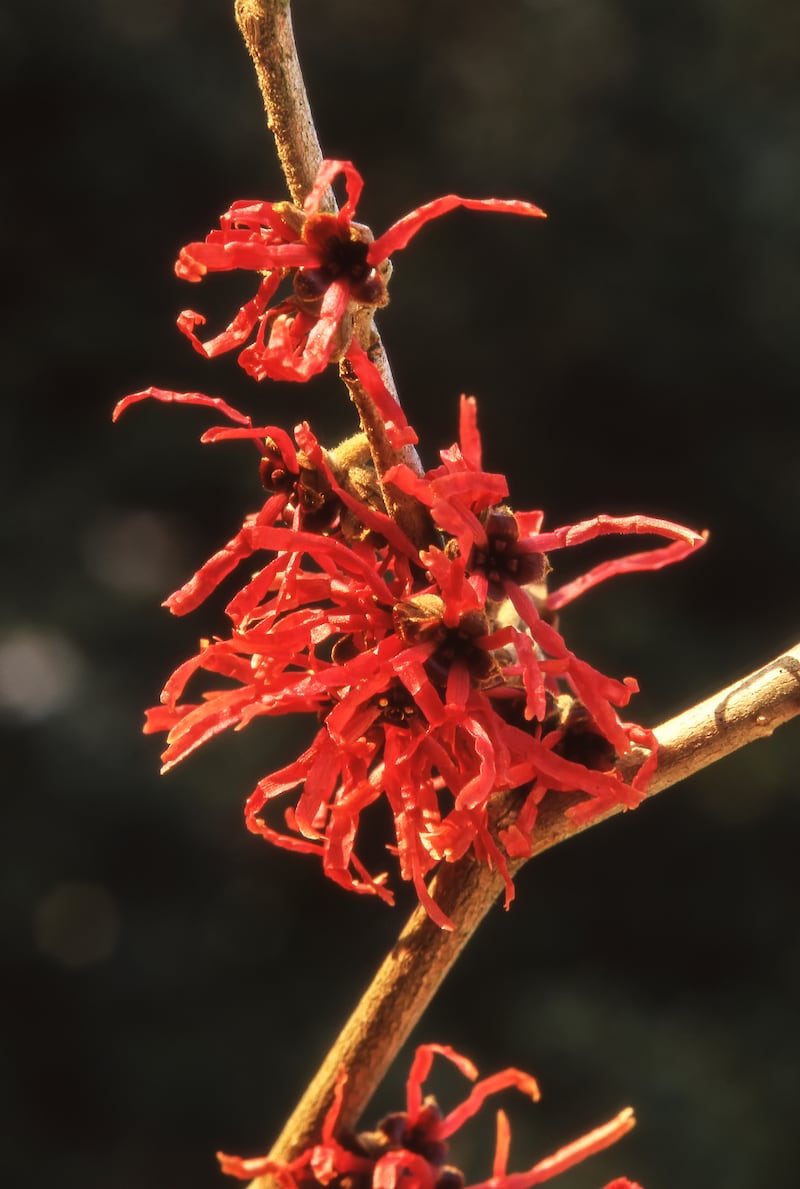
Elegant and understated yet with a stately presence all their own, these exceptionally long-lived, slow-growing, spreading shrubs bring the garden to life in late winter-very early spring when their tight clusters of tattered, intensely perfumed flowers unfurl on bare branches. An edge-of woodland species, they are like a cool, damp but free-draining, humus-rich soil and a sheltered spot in dappled shade or full sun. Recommended varieties include the copper-orange flowered Hamamelis x intermedia “Jelena” and the lemon-yellow Hamamelis “Pallida”. Witch-hazels can also be grown in a large tub or even fan trained against a wall if required, but you’ll need to prune them skilfully to keep them in shape (see the Royal Horticultural Society for step-by-step instructions).
Viburnum bodnantense
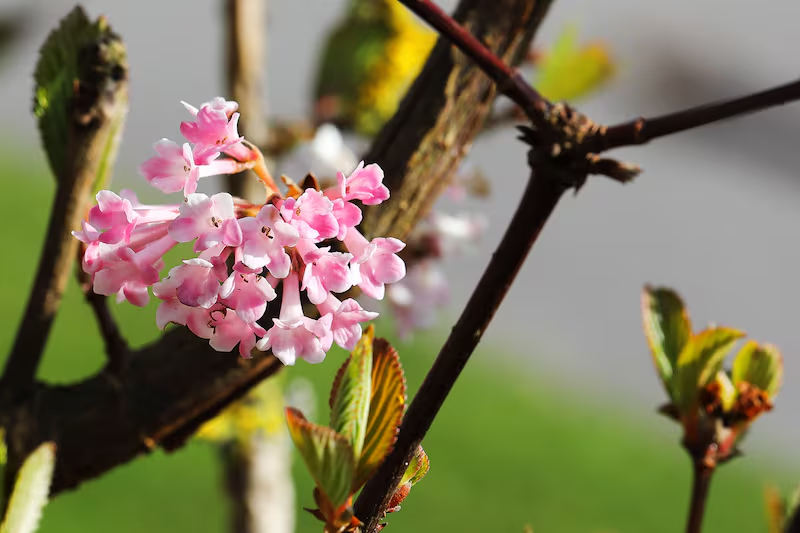
Would gardeners give this hardy, decorative shrub a second glance if it bloomed in June rather than from midwinter into March? Possibly not, but that’s not to take away from its special brand of pared-back, twiggy beauty. Dense clusters of intensely perfumed, long-lasting, pink flowers open intermittently on bare branches for months on end but come to a crescendo in early spring. Exceptionally hardy, long-lived, fast-growing but tolerant of hard pruning, two varieties are commonly available, Viburnum “Dawn” (dark pink) and Viburnum “Charles Lamont” (pale pink), both of which make upright shrubs reaching an average height and spread of 3-4m.
Daphne
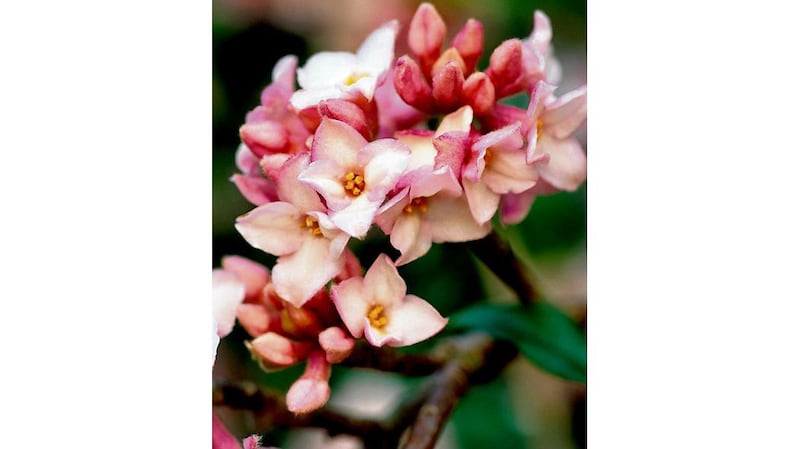
Another slow-growing, evergreen, scented goddess of the early spring garden whose popularity has withstood the whims of fashion, the classic variety is Daphne ‘Jacqueline Postil’, which slowly reaches a height and spread of 4m x 2m. It’s been joined in recent years by a handful of new, more compact varieties such as Daphne “Perfume Princess White”, that has been bred for larger flowers, but which packs the same divinely-scented punch. All like a sheltered position and a cool, humus-rich, moist but free-draining soil in full sun or dappled shade, ideally by an entrance where their astonishing perfume can be easily appreciated. A generous organic mulch around the base of the plant in autumn will help to protect its roots from winter cold.
Garrya elliptica (silk tassel bush)
As if being robust, hardy and evergreen weren’t enough good reasons to consider growing the silver tassel bush, it also produces an abundance of the most extraordinary dangling silver-grey flower catkins in late winter-early spring. The only thing this undemanding, easy-to-grow, very decorative shrub asks for is shelter from cold winds, so place it somewhere to the back of a border or near a sunny wall where it will provide a great backdrop for later flowering plants. Seek out the male cultivar, Garrya “James Roof”, which is prized for its particularly long flower tassels. Height and spread of four metres.
Prunus subhirtella ‘Autumnalis’ (winter flowering cherry)
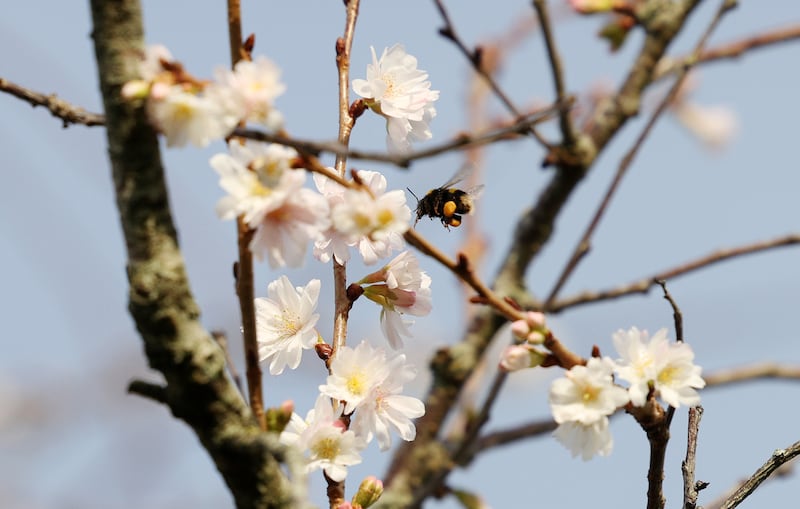
Long, long before the main cherry blossom season gets into its stride, this exceptionally long-flowering, deciduous tree starts to burst into bloom. In a mild autumn, that can be as early as October and continue intermittently well into March. Along with the white-flowering “Autumnalis”, there’s also a pale-pink flowering variety available known as Prunus “Autumnalis Rosea”. Reaching an average height and spread of 3 metres x 8 metres, this small hardy tree likes an averagely fertile, moist but free-draining soil in full sun.
Magnolia stellata (star magnolia)
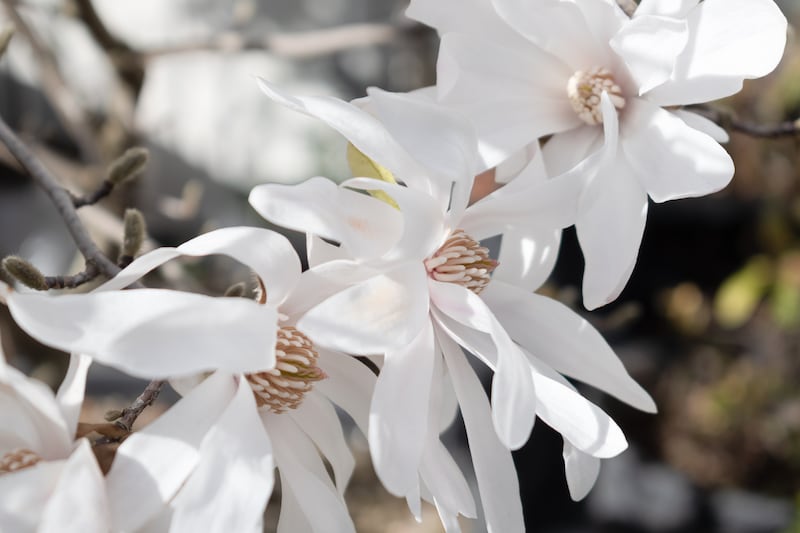
The late, great gardener and author Christopher Lloyd once wrote of magnolias that “they make beautiful old bones”, a description which very aptly captures their grace. Slow growing, the star magnolia starts to bloom from March, each snowy, star-shaped bloom unfurling from velvety grey-brown buds arranged along its bare branches before the leaves follow a month or so later. Unlike many magnolias, it will also tolerate an alkaline soil and is a great choice for smaller gardens or even for growing in a large tub. Just make sure to give it a sheltered spot in full sun or dappled shade where harsh spring frosts won’t sear its flowers. Height and spread of 2.5 metres x 4 metres.
Chimonanthus praecox (wintersweet)
It’s not easy to grow well, requiring a sheltered sunny wall in a mild garden and careful training to keep its messy growth habit in check. But this deciduous shrub’s clusters of waxy, dark-eyed, lemon-yellow, fragrant flowers, which appear in late winter-early spring, are heavenly. Height and spread of 3 metres-4 metres.
Camellia x williamsii
Not everyone is a fan of this hardy, long-lived, early spring-blooming shrub, but those that are adore it for its glossy, architectural, evergreen foliage and large, often multi-petalled flowers that come in shades of pink, white, red, cream and pale yellow. Another edge-of-woodland species, it likes a sheltered position in dappled shade where its emerging flowers are protected from cold winds and icy spring frosts. An ericaceous shrub that needs a cool, damp, humus-rich acid soil, it will happily grow in a large tub as long as it’s given an ericaceous compost and kept well-watered through the year (inadequate and/or irregular watering prevents it from flowering properly the following year). Outstanding varieties include the anemone-flowered, buttermilk-yellow Camellia “Jury’s Yellow”; the bright pink, peony-flowered Camellia ‘Anticipation’ and the snow-white Camellia ‘Bridal Gown’. Height and spread depends on the particular variety, but is typically between 2.5 metres- 4 metres.
This week in the garden
Don’t let the occasional spell of unusually mild, bright early spring weather, trick you into sowing half-hardy flowering annuals just yet. Even if you can offer them a protected, frost-free growing space under cover of a glasshouse, polytunnel or on a bright windowsill, the threat of frost means that they still can’t go outdoors into their final growing positions until late May at the earliest, before which they run the risk of becoming pot bound and running out of nutrients. Instead, hold off until the second half of March for undercover sowing.
Avoid mowing areas of the lawn where snowdrops, crocuses, winter aconites and other late winter/early spring flowering bulbs have recently finished flowering, which will damage their growth and ability to flower well next year as well as preventing them from self-seeding.
Dates for your diary
Monday, February 26th (8.30pm): Carrigtwohill Community Hall, Growing Food for Taste, a talk by Cork Roof Top Garden chef Brian Murray on behalf of Carrigtwohill Flower & Garden Club.
Monday, March 11th: The closing date for community garden groups, schools, charitable organisations and garden clubs to submit an application to design and create postcard gardens at Bloom 2024, which takes place in Dublin’s Phoenix Park over the June Bank Holiday weekend. bordbiabloom.ie
Friday, March 15th: Ballymaloe Cookery School, Shanagarry, Co Cork: How to Grow and Arrange Your Own Cut-Flowers Seasonally and Sustainably, a one-day hands-on workshop with organic gardener, flower farmer-florist and Irish Times gardening columnist Fionnuala Fallon. ballymaloecookeryschool.ie
Saturday, March 23rd: Dunmore Cookery School, Durrow, Co Laois, How to Grow Your Own Food Sustainably, a one-day hands-on course with organic gardener and writer Tanguy de Toulgoët. dunmorecountryschool.ie for booking details
- Sign up for push alerts and have the best news, analysis and comment delivered directly to your phone
- Find The Irish Times on WhatsApp and stay up to date
- Our In The News podcast is now published daily – Find the latest episode here





















